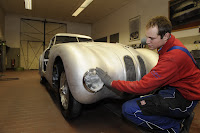
BMW Classic is getting itself in the news like crazy. First, the sub-brand opens up a dedicated Motorsport division. Then they start doing a limited number of tours around Munich in classy, old-school chariots. Now, Classic announced that it has recreated the BMW's 328 Kamm Coupé to celebrate the 70th anniversary of BMW's win at the Mille Miglia.
 The original Kamm Coupé, named after aero-pioneer Wunibald Kamm, was the only one of BMW's five Mille Miglia cars to remain in Germany after the war, ultimately ending up destroyed in a scrap heap somewhere in 1953. Now, in order to make its troupe of traveling 1940 sports cars complete, BMW Classic has built an exact replica from scratch.
The original Kamm Coupé, named after aero-pioneer Wunibald Kamm, was the only one of BMW's five Mille Miglia cars to remain in Germany after the war, ultimately ending up destroyed in a scrap heap somewhere in 1953. Now, in order to make its troupe of traveling 1940 sports cars complete, BMW Classic has built an exact replica from scratch.
Karl Baumer, BMW Classic director, described the process: "We've come up against some major technical challenges, had many discussions and racked up countless hours of research, but when you see the car for the first time you can sense the passion and expertise invested in the project by everyone involved – all those years ago and today."
The project intitiall started in the 1990s, but there was a serious lack of information regarding the car. Only after receiving aid from a private collector who had detailed photographs of the car (including "a good number of shots detailing the car's tubular frame construction") could they proceed.
Starting by scanning the photos and doing a lot of computer-3D hocus-pocus to establish placement, position, and size of parts, BMW ended up with enough information to add a 3D model to a cutting program that would carve a full-scale model out of foam.
After the Kamm's form was realized, the process was relatively easy: stretch an original chassis, build a space frame for it, stall the project for a while, reignite the dream, and then get back to building the car. After working with a master craftsman's school for initial body work (that would end up on display at BMW's museum), BMW went to a well-known restorer for the full recreation.
René Große, the man behind BMW's 328 Touring Coupé and Mille Miglia Roadster restorations, meticulously crafted an aluminum body (instead of Elektron) and then set to work on the under-body panels. These included "inner front wings, bulkhead, double floor section of the body, dashboard,...fuel tank, etc.".
Other than starting from virtually nothing, BMW says its other challenges included dealing with a set-back radiator, the entire power/drive train, and the modified rear axle. Judging by the pics, it was well worth it.
For a short history on what the 1940 Mille Miglia cars (3 roadsters, a Touring Coupe, and the Kamm Coupé) went through during and after the war, scroll down for an excerpt from the press release.
"BMW was quick to appreciate the unique status of its Mille Miglia cars following the victory in 1940, and they were soon moved out of Munich into a rural hideaway to save them from potential destruction during the Second World War. The evacuation was successful, with all five surviving the hostilities essentially unscathed. However, in the upheaval of the immediate post-war period BMW lost track of the cars. With Allied soldiers scouring Germany for rare racing cars, it was hardly surprising that the three Mille Miglia Roadsters resurfaced in Russia, England and America. The winning Touring Coupé from 1940 was initially seized by the Americans before being whisked away by a senior BMW employee. However, it also found its way across the Atlantic when the employee decided to emigrate.
Only the Kamm Coupé remained in Germany, former BMW Director of Racing Ernst Loof having acquired the car for his personal use. By this time he had become a manufacturer in his own right, supplying speedy Veritas racing sports cars to customers in a resurgent post-war Germany.
However, he also laboured consistently under financial woes and a few years later he was forced to part company with the Kamm Coupé. Sadly, this automotive gem was not blessed with a long life under its new owner, succumbing to the scrap heap after an accident in the early 1950s."
By Phil Alex




















































































